FORD CONTOUR 1998 2.G Owners Manual
Manufacturer: FORD, Model Year: 1998, Model line: CONTOUR, Model: FORD CONTOUR 1998 2.GPages: 200, PDF Size: 2.7 MB
Page 161 of 200
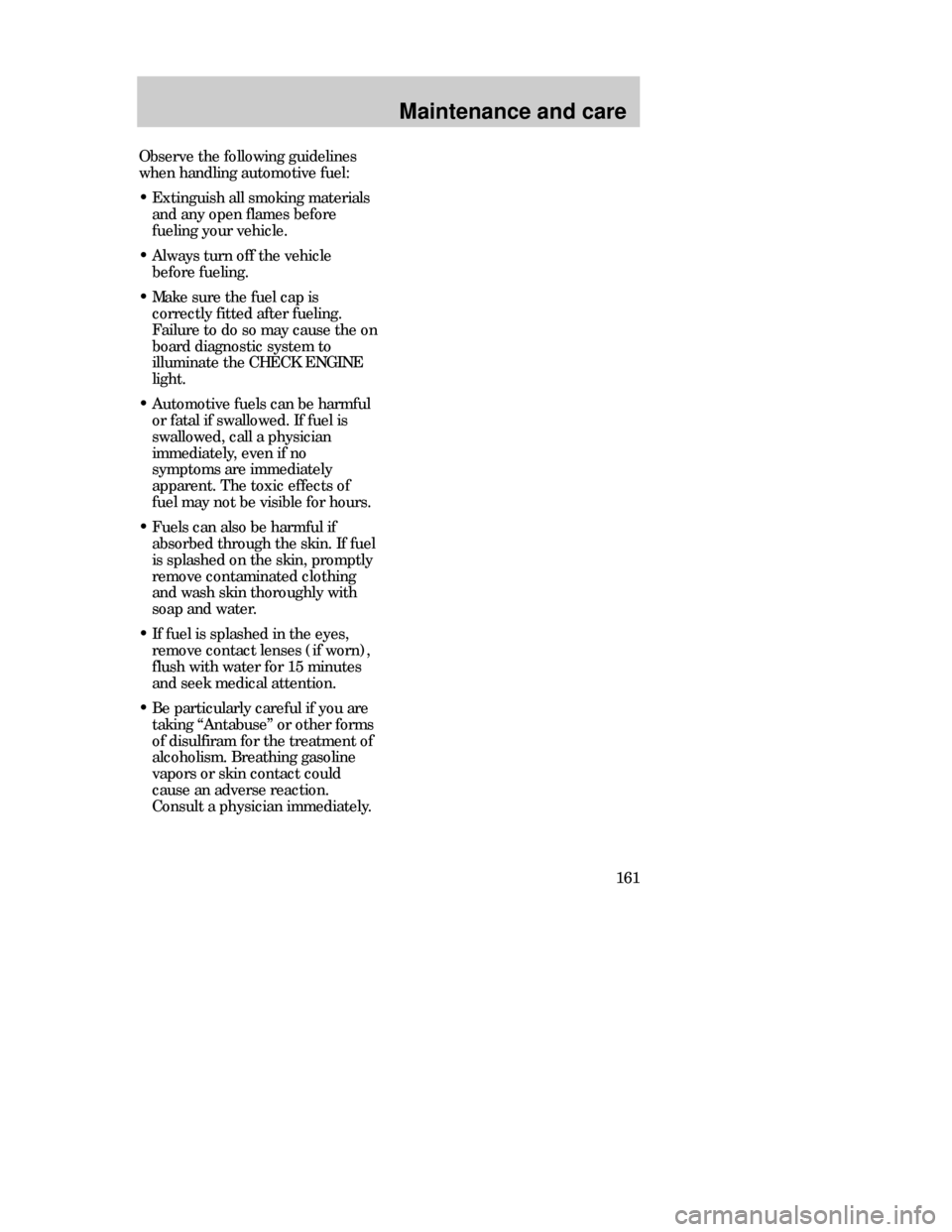
Maintenance and care
161 Observe the following guidelines
when handling automotive fuel:
•Extinguish all smoking materials
and any open flames before
fueling your vehicle.
•Always turn off the vehicle
before fueling.
•Make sure the fuel cap is
correctly fitted after fueling.
Failure to do so may cause the on
board diagnostic system to
illuminate the CHECK ENGINE
light.
•Automotive fuels can be harmful
or fatal if swallowed. If fuel is
swallowed, call a physician
immediately, even if no
symptoms are immediately
apparent. The toxic effects of
fuel may not be visible for hours.
•Fuels can also be harmful if
absorbed through the skin. If fuel
is splashed on the skin, promptly
remove contaminated clothing
and wash skin thoroughly with
soap and water.
•If fuel is splashed in the eyes,
remove contact lenses (if worn),
flush with water for 15 minutes
and seek medical attention.
•Be particularly careful if you are
taking “Antabuse” or other forms
of disulfiram for the treatment of
alcoholism. Breathing gasoline
vapors or skin contact could
cause an adverse reaction.
Consult a physician immediately.
CDW VA1-19Maint en C 5/15/97 8:56 PM Page 161
Page 162 of 200
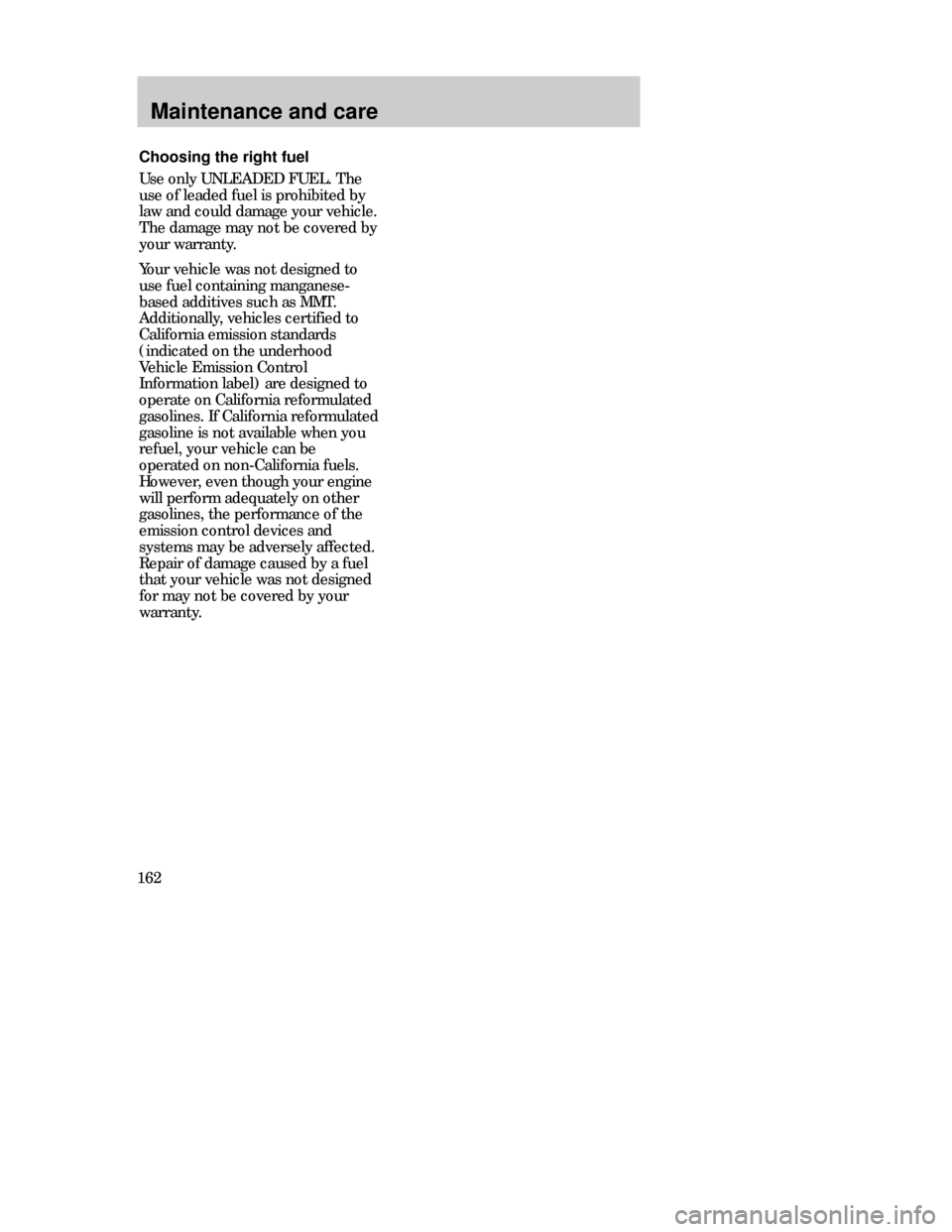
Maintenance and care
162Choosing the right fuel
Use only UNLEADED FUEL. The
use of leaded fuel is prohibited by
law and could damage your vehicle.
The damage may not be covered by
your warranty.
Your vehicle was not designed to
use fuel containing manganese-
based additives such as MMT.
Additionally, vehicles certified to
California emission standards
(indicated on the underhood
Vehicle Emission Control
Information label) are designed to
operate on California reformulated
gasolines. If California reformulated
gasoline is not available when you
refuel, your vehicle can be
operated on non-California fuels.
However, even though your engine
will perform adequately on other
gasolines, the performance of the
emission control devices and
systems may be adversely affected.
Repair of damage caused by a fuel
that your vehicle was not designed
for may not be covered by your
warranty.
CDW VA1-19Maint en C 5/15/97 8:56 PM Page 162
Page 163 of 200
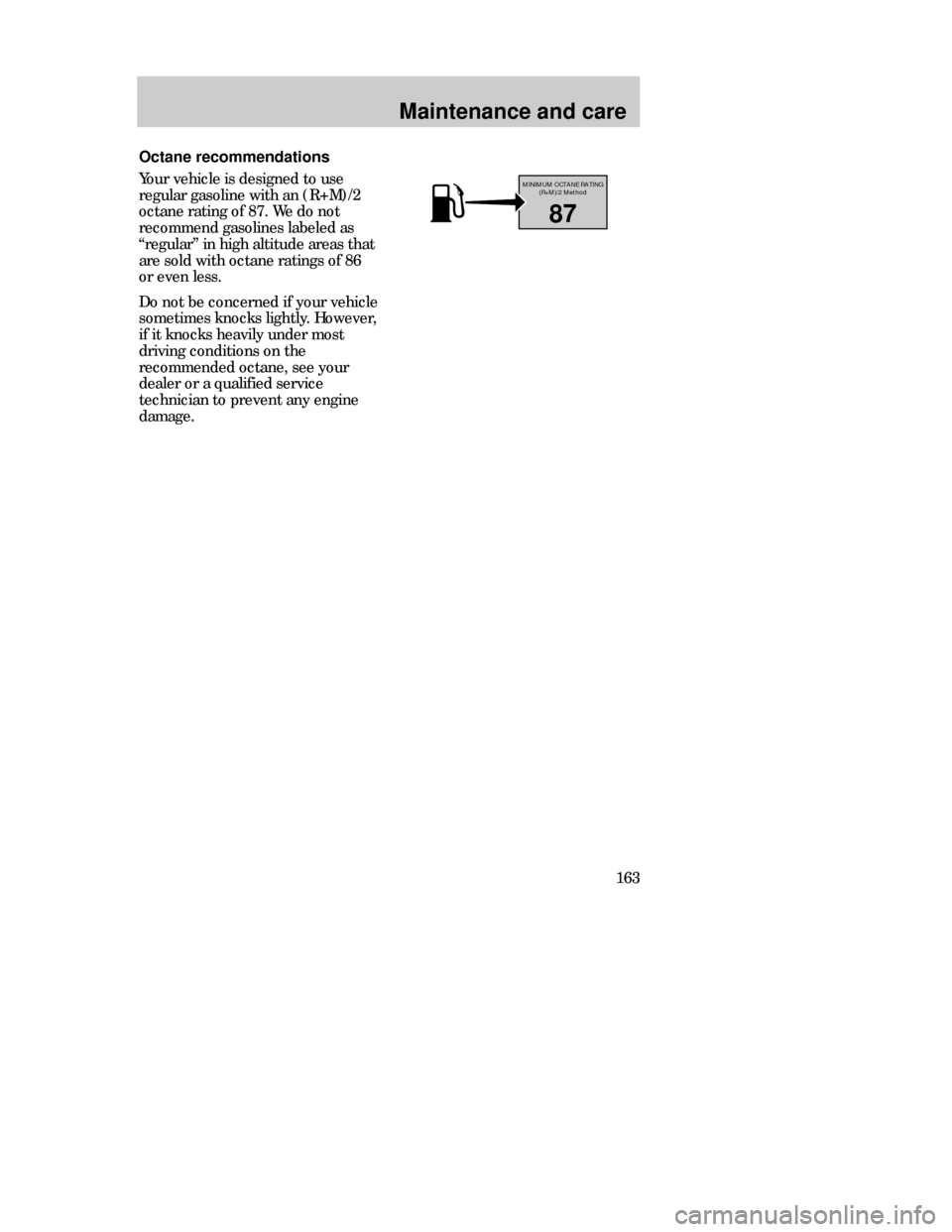
Maintenance and care
163 Octane recommendations
Your vehicle is designed to use
regular gasoline with an (R+M)/2
octane rating of 87. We do not
recommend gasolines labeled as
“regular” in high altitude areas that
are sold with octane ratings of 86
or even less.
Do not be concerned if your vehicle
sometimes knocks lightly. However,
if it knocks heavily under most
driving conditions on the
recommended octane, see your
dealer or a qualified service
technician to prevent any engine
damage.
87
MINIMUM OCTANE RATING
(R+M)/2 Method
CDW VA1-19Maint en C 5/15/97 8:56 PM Page 163
Page 164 of 200
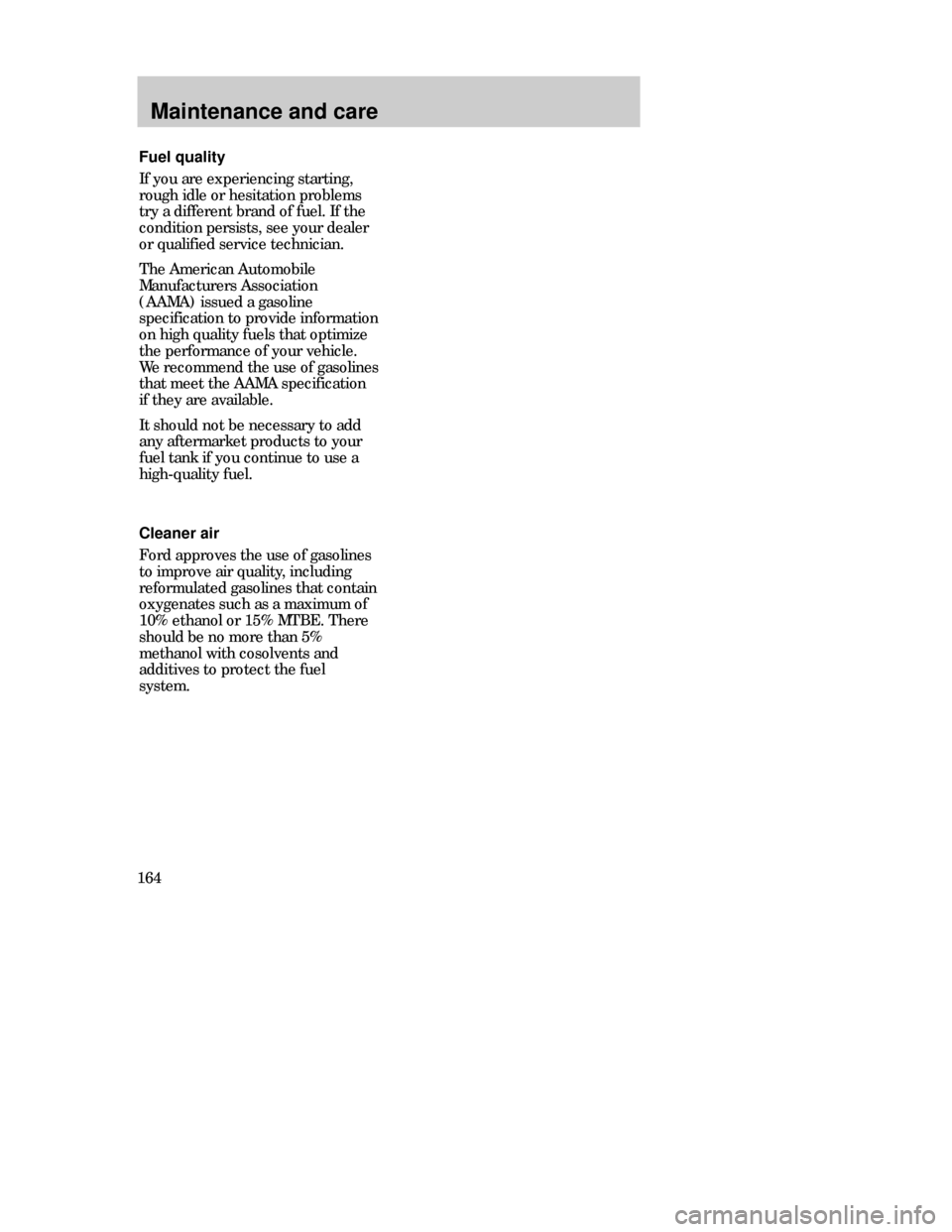
Maintenance and care
164Fuel quality
If you are experiencing starting,
rough idle or hesitation problems
try a different brand of fuel. If the
condition persists, see your dealer
or qualified service technician.
The American Automobile
Manufacturers Association
(AAMA) issued a gasoline
specification to provide information
on high quality fuels that optimize
the performance of your vehicle.
We recommend the use of gasolines
that meet the AAMA specification
if they are available.
It should not be necessary to add
any aftermarket products to your
fuel tank if you continue to use a
high-quality fuel.
Cleaner air
Ford approves the use of gasolines
to improve air quality, including
reformulated gasolines that contain
oxygenates such as a maximum of
10% ethanol or 15% MTBE. There
should be no more than 5%
methanol with cosolvents and
additives to protect the fuel
system.
CDW VA1-19Maint en C 5/15/97 8:56 PM Page 164
Page 165 of 200
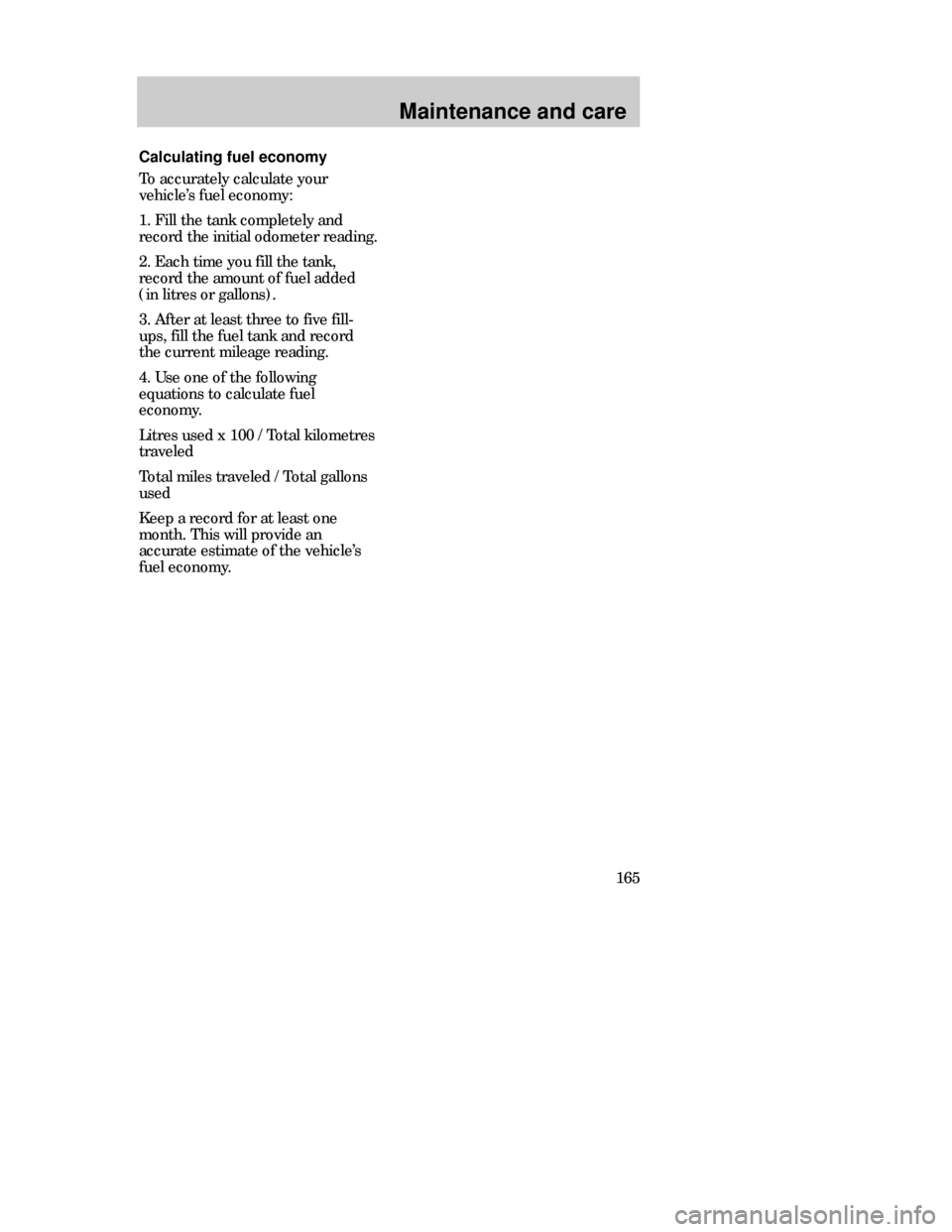
Maintenance and care
165 Calculating fuel economy
To accurately calculate your
vehicle’s fuel economy:
1. Fill the tank completely and
record the initial odometer reading.
2. Each time you fill the tank,
record the amount of fuel added
(in litres or gallons).
3. After at least three to five fill-
ups, fill the fuel tank and record
the current mileage reading.
4. Use one of the following
equations to calculate fuel
economy.
Litres used x 100 / Total kilometres
traveled
Total miles traveled / Total gallons
used
Keep a record for at least one
month. This will provide an
accurate estimate of the vehicle’s
fuel economy.
CDW VA1-19Maint en C 5/15/97 8:56 PM Page 165
Page 166 of 200
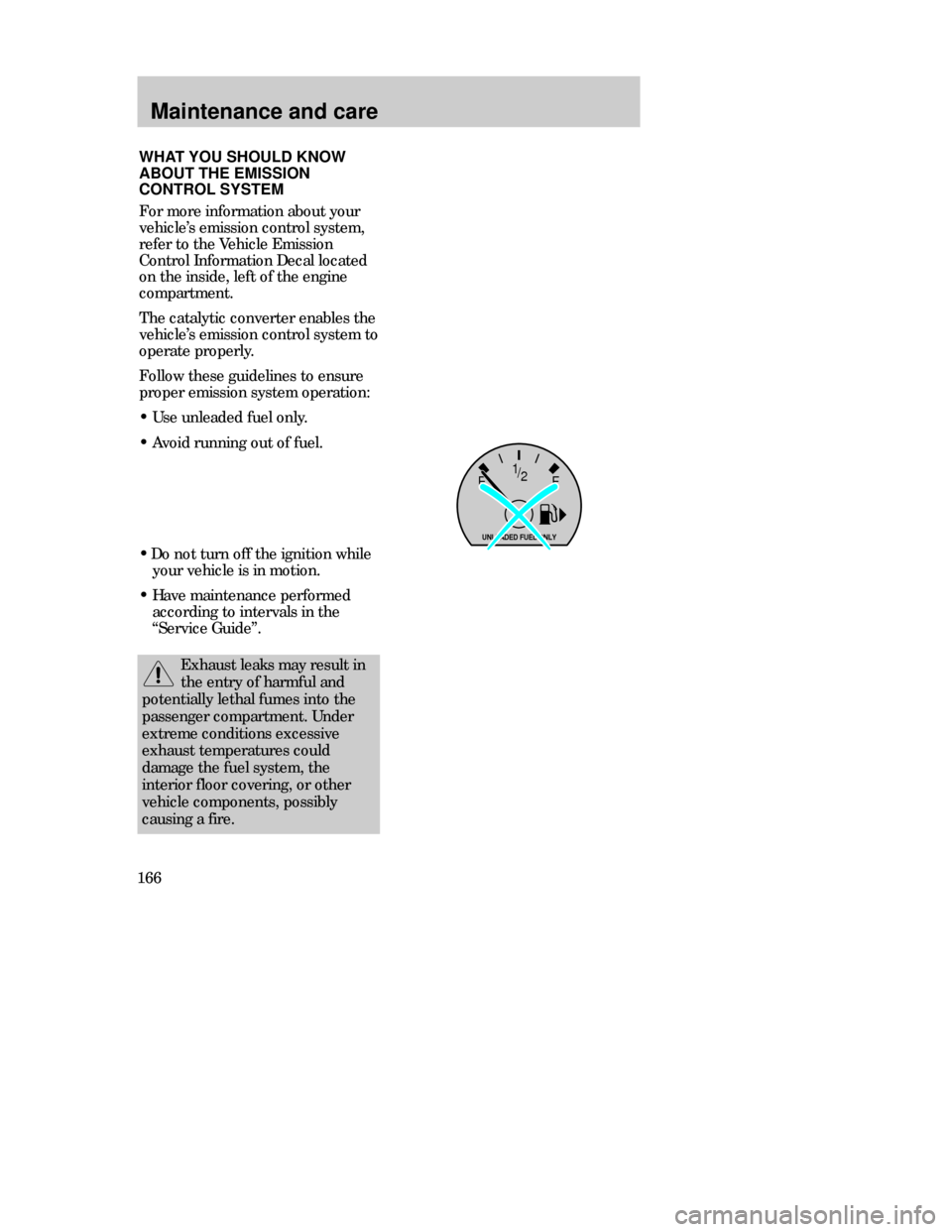
Maintenance and care
166WHAT YOU SHOULD KNOW
ABOUT THE EMISSION
CONTROLSYSTEM
For more information about your
vehicle’s emission control system,
refer to the Vehicle Emission
Control Information Decal located
on the inside, left of the engine
compartment.
The catalytic converter enables the
vehicle’s emission control system to
operate properly.
Follow these guidelines to ensure
proper emission system operation:
•Use unleaded fuel only.
•Avoid running out of fuel.
EF 1
/
2
UNLEADED FUEL ONLY
• Do not turn off the ignition while
your vehicle is in motion.
•Have maintenance performed
according to intervals in the
“Service Guide”.
Exhaust leaks may result in
the entry of harmful and
potentially lethal fumes into the
passenger compartment. Under
extreme conditions excessive
exhaust temperatures could
damage the fuel system, the
interior floor covering, or other
vehicle components, possibly
causing a fire.
CDW VA1-19Maint en C 5/15/97 8:56 PM Page 166
Page 167 of 200
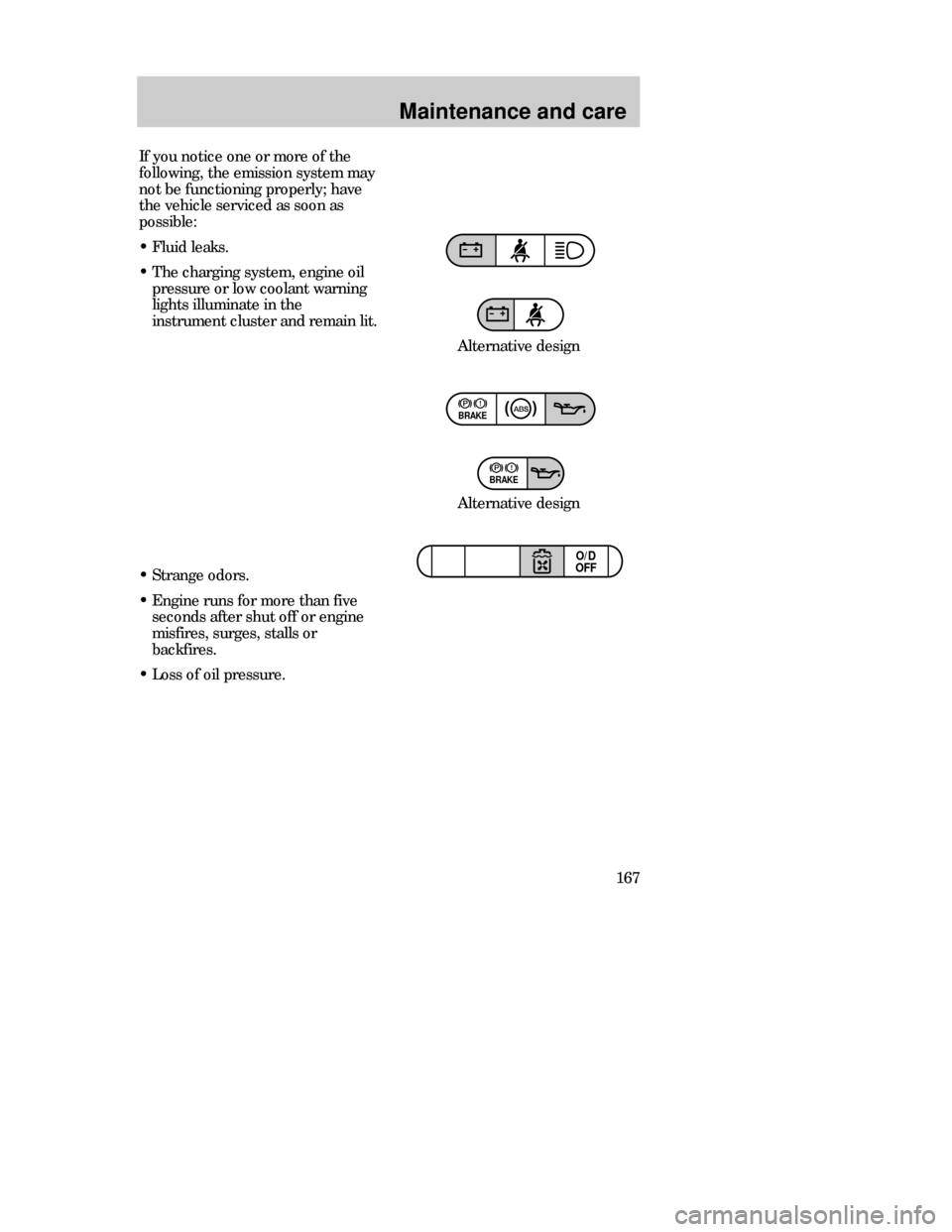
Maintenance and care
167
BRAKE
BRAKE
TRACTION
CONTROLO/D
OFF
If you notice one or more of the
following, the emission system may
not be functioning properly; have
the vehicle serviced as soon as
possible:
•Fluid leaks.
•The charging system, engine oil
pressure or low coolant warning
lights illuminate in the
instrument cluster and remain lit.
•Strange odors.
•Engine runs for more than five
seconds after shut off or engine
misfires, surges, stalls or
backfires.
•Loss of oil pressure.Alternative design Alternative design
CDW VA1-19Maint en C 5/15/97 8:56 PM Page 167
Page 168 of 200
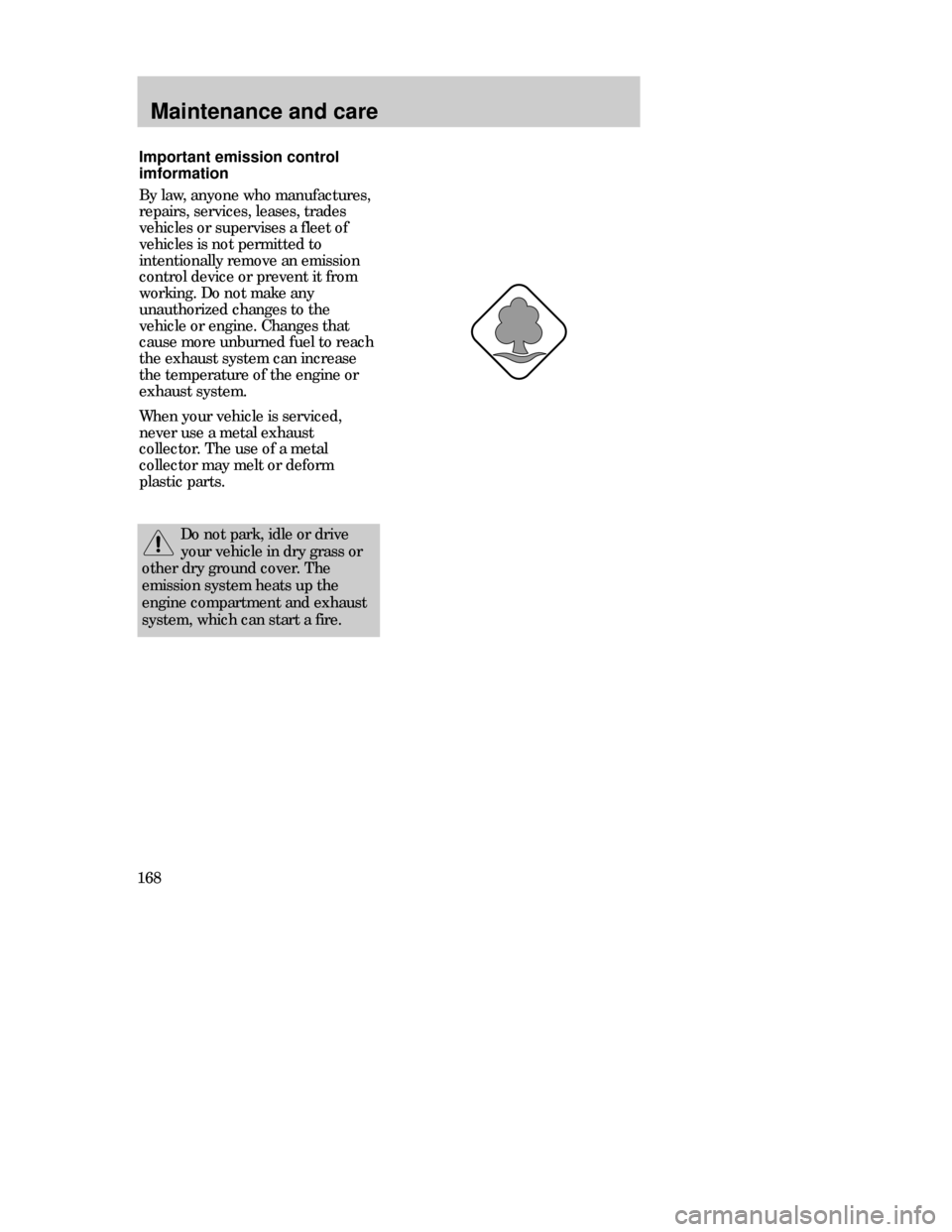
Maintenance and care
168
Do not park, idle or drive
your vehicle in dry grass or
other dry ground cover. The
emission system heats up the
engine compartment and exhaust
system, which can start a fire.
Important emission control
imformation
By law, anyone who manufactures,
repairs, services, leases, trades
vehicles or supervises a fleet of
vehicles is not permitted to
intentionally remove an emission
control device or prevent it from
working. Do not make any
unauthorized changes to the
vehicle or engine. Changes that
cause more unburned fuel to reach
the exhaust system can increase
the temperature of the engine or
exhaust system.
When your vehicle is serviced,
never use a metal exhaust
collector. The use of a metal
collector may melt or deform
plastic parts.
CDW VA1-19Maint en C 5/15/97 8:56 PM Page 168
Page 169 of 200
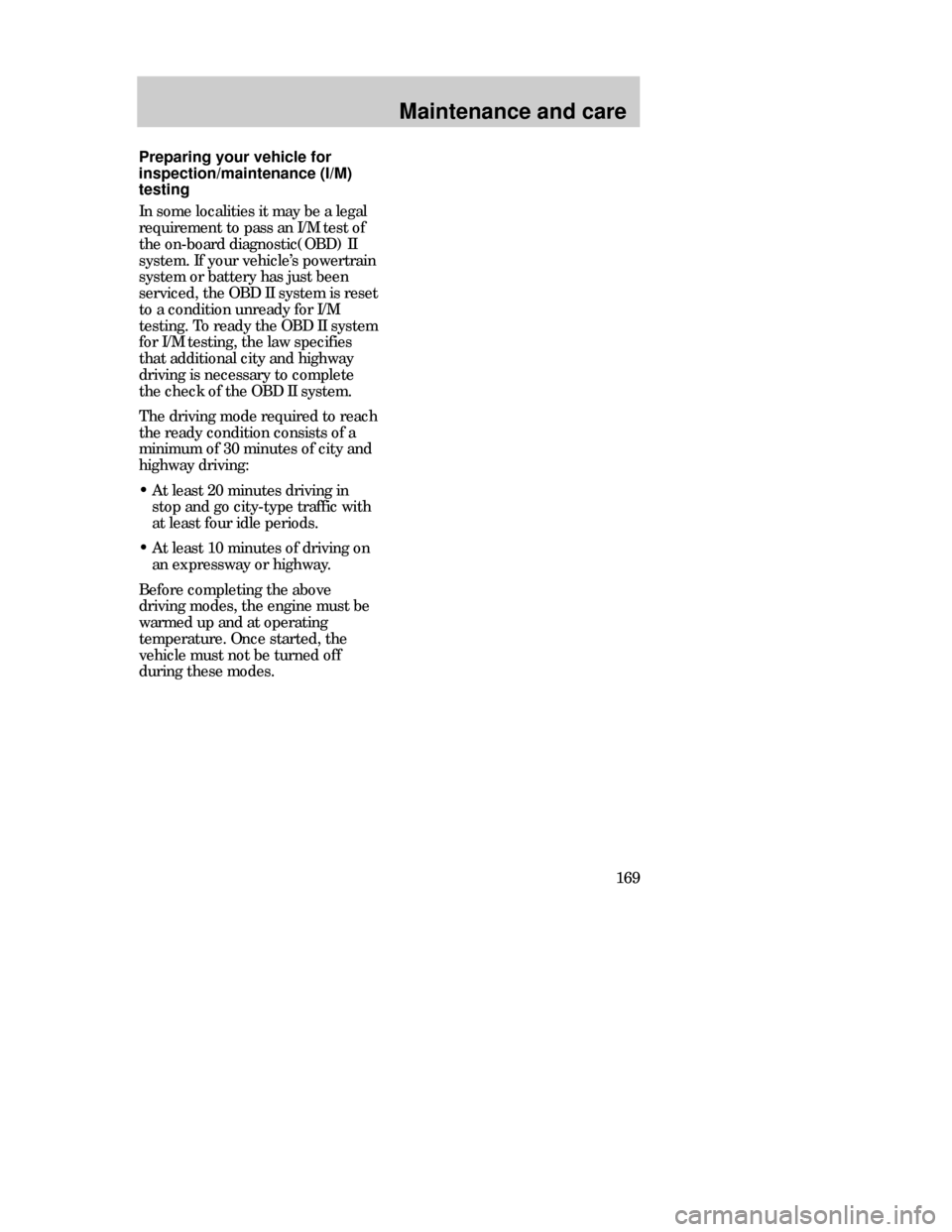
Maintenance and care
169 Preparing your vehicle for
inspection/maintenance (I/M)
testing
In some localities it may be a legal
requirement to pass an I/M test of
the on-board diagnostic(OBD) II
system. If your vehicle’s powertrain
system or battery has just been
serviced, the OBD II system is reset
to a condition unready for I/M
testing. To ready the OBDII system
for I/M testing, the law specifies
that additional city and highway
driving is necessary to complete
the check of the OBDII system.
The driving mode required to reach
the ready condition consists of a
minimum of 30 minutes of city and
highway driving:
•At least 20 minutes driving in
stop and go city-type traffic with
at least four idle periods.
•At least 10 minutes of driving on
an expressway or highway.
Before completing the above
driving modes, the engine must be
warmed up and at operating
temperature. Once started, the
vehicle must not be turned off
during these modes.
CDW VA1-19Maint en C 5/15/97 8:56 PM Page 169
Page 170 of 200
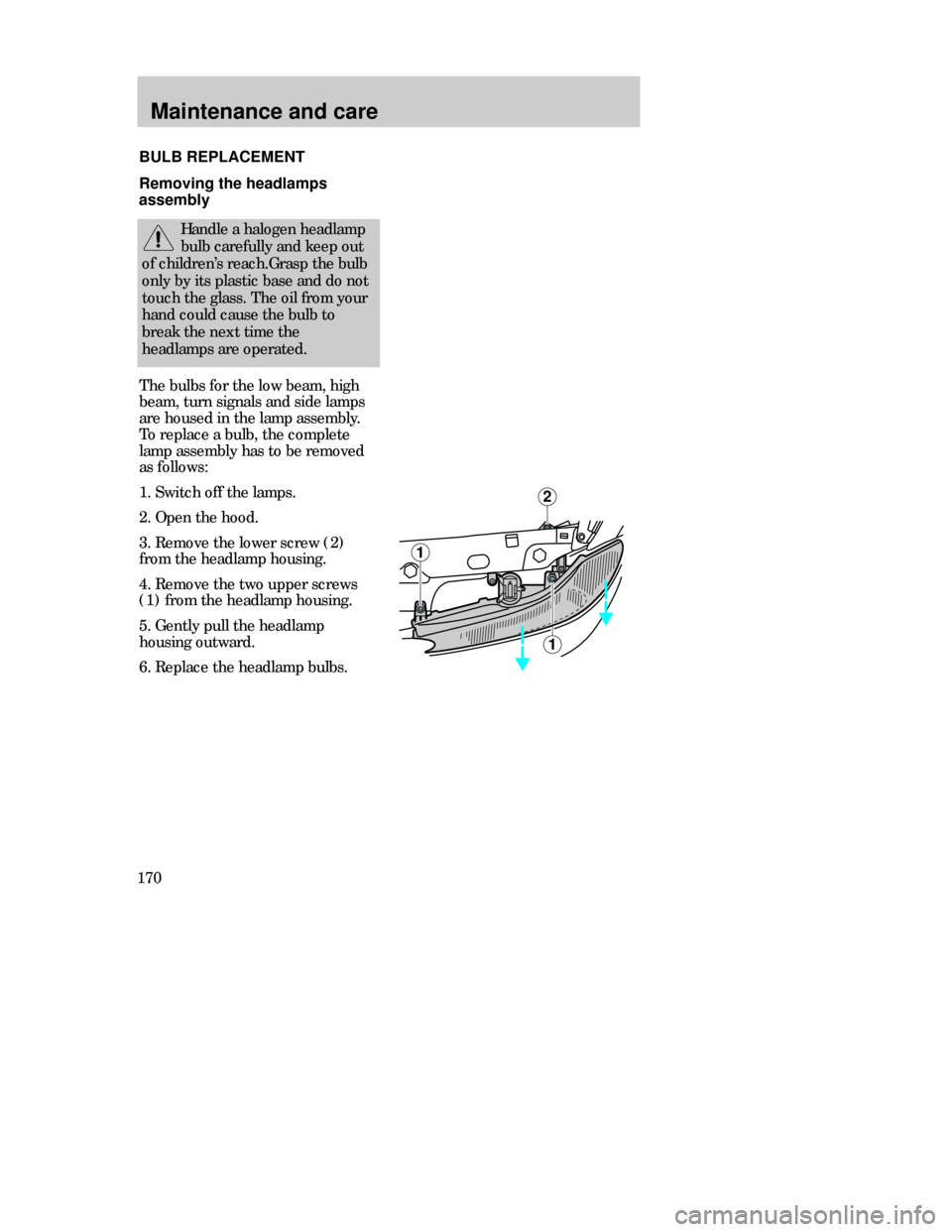
Maintenance and care
170The bulbs for the low beam, high
beam, turn signals and side lamps
are housed in the lamp assembly.
To replace a bulb, the complete
lamp assembly has to be removed
as follows:
1. Switch off the lamps.
2. Open the hood.
3. Remove the lower screw (2)
from the headlamp housing.
4. Remove the two upper screws
(1) from the headlamp housing.
5. Gently pull the headlamp
housing outward.
6. Replace the headlamp bulbs. BULB REPLACEMENT
Handle a halogen headlamp
bulb carefully and keep out
of children’s reach.Grasp the bulb
only by its plastic base and do not
touch the glass. The oil from your
hand could cause the bulb to
break the next time the
headlamps are operated.
1
1
2
Removing the headlamps
assembly
CDW VA1-19Maint en C 5/15/97 8:56 PM Page 170